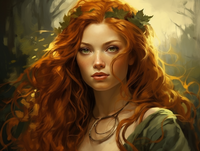Gótana: Difference between revisions
(Created page with "In Lághalukkan mythology, '''Cóadanna''' ({{wpl|Old Irish|Old Cordic}}; {{wpl|modern Irish|Meallaigian}}: '''Gaethána'''; {{wpl|Proto Norse|Proto-Canamo}}: '''Hwôþann...") |
|||
| (3 intermediate revisions by the same user not shown) | |||
| Line 1: | Line 1: | ||
In [[Lághalukkan mythology]], | In [[Lághalukkan mythology]], ({{wpl|Old Irish|Old Cordic}}: '''Cóadanna'''; {{wpl|modern Irish|Meallaigian}}: '''Gaethána'''; {{wpl|Proto Norse|Proto-Canamo}}: '''Hwôþanna'''; [[Götaish Language|Götaish]]; '''Gótana''', daughter of [[Tirós|Teros]] and [[Himinfögnu]] of the [[Ailteoirí Dílse]], was the eponymous matron {{wpl|goddess}} of [[Gotneska]]. | ||
[[File:Beaut of Gotana.png|200px]] | <center>[[File:Beaut of Gotana.png|200px]] | ||
“The Beauty of Gótana” painting by [[Criosán Andersson]]. | <br>“The Beauty of Gótana” painting by [[Criosán Andersson]].</br></center> | ||
==Tale of the Goddess of Fertility and Abundance== | |||
In the ancient realm of mystic lands where [[Córda|Cordic]] and {{wpl|Norse|Canamoan}} cultures intertwined, there existed a goddess named Gotana. She was the embodiment of fertility, abundance, and protection, and her presence brought prosperity and harmony to the land. | |||
Gotana was revered as the goddess of the harvest, her divine touch ensuring bountiful crops that sustained the people through the changing seasons. As the fields flourished under her watchful eye, the people celebrated her with joyous festivals, offering gratitude for the abundance bestowed upon them. | |||
Beyond her role as the goddess of fertility and abundance, Gotana was also known as a guardian deity. She held a deep connection to the land and its inhabitants, fiercely protecting them from any harm or malevolent forces that sought to disrupt the harmony. Her presence brought a sense of security and peace, comforting the people in times of uncertainty. | |||
Legend tells of an instance when a dark force loomed over the realm, threatening to engulf the land in chaos and destruction. Gotana, with her radiant aura and unwavering determination, took it upon herself to stand against this malevolence. She rallied the forces of nature, calling upon the spirits of the earth, the wind, and the waters to join her in the battle. | |||
With her divine powers, Gotana unleashed a torrent of energy, driving back the darkness and restoring balance to the land. Her bravery and resilience became a symbol of hope for her devotees, inspiring them to face their own challenges with unwavering strength and determination. | |||
In gratitude for her protection and blessings, the people built temples in honor of Gotana, adorning them with vibrant offerings of flowers, fruits, and sheaves of golden wheat. They sought her guidance in matters of the heart, fertility, and protection, turning to her wisdom and benevolence during times of both celebration and hardship. | |||
Through the ages, the legacy of Gotana endured, her name whispered in prayers and her stories shared around hearthfires. She remained a cherished figure, reminding the people of the interconnectedness of life, the importance of nurturing the earth, and the power of protection and abundance. | |||
Even in the modern world, where ancient beliefs blend with new understandings, the spirit of Gotana lives on. She continues to inspire reverence and awe, reminding us to honor the fertility of the land, to cultivate abundance, and to protect the precious gifts bestowed upon us by the divine forces of nature. | |||
{{Template:Gotneska topics}} | |||
[[Category:Gotneska]] | |||
{{Eurth}} | |||
Latest revision as of 16:10, 15 August 2023
In Lághalukkan mythology, (Old Cordic: Cóadanna; Meallaigian: Gaethána; Proto-Canamo: Hwôþanna; Götaish; Gótana, daughter of Teros and Himinfögnu of the Ailteoirí Dílse, was the eponymous matron goddess of Gotneska.

“The Beauty of Gótana” painting by Criosán Andersson.
Tale of the Goddess of Fertility and Abundance
In the ancient realm of mystic lands where Cordic and Canamoan cultures intertwined, there existed a goddess named Gotana. She was the embodiment of fertility, abundance, and protection, and her presence brought prosperity and harmony to the land.
Gotana was revered as the goddess of the harvest, her divine touch ensuring bountiful crops that sustained the people through the changing seasons. As the fields flourished under her watchful eye, the people celebrated her with joyous festivals, offering gratitude for the abundance bestowed upon them.
Beyond her role as the goddess of fertility and abundance, Gotana was also known as a guardian deity. She held a deep connection to the land and its inhabitants, fiercely protecting them from any harm or malevolent forces that sought to disrupt the harmony. Her presence brought a sense of security and peace, comforting the people in times of uncertainty.
Legend tells of an instance when a dark force loomed over the realm, threatening to engulf the land in chaos and destruction. Gotana, with her radiant aura and unwavering determination, took it upon herself to stand against this malevolence. She rallied the forces of nature, calling upon the spirits of the earth, the wind, and the waters to join her in the battle.
With her divine powers, Gotana unleashed a torrent of energy, driving back the darkness and restoring balance to the land. Her bravery and resilience became a symbol of hope for her devotees, inspiring them to face their own challenges with unwavering strength and determination.
In gratitude for her protection and blessings, the people built temples in honor of Gotana, adorning them with vibrant offerings of flowers, fruits, and sheaves of golden wheat. They sought her guidance in matters of the heart, fertility, and protection, turning to her wisdom and benevolence during times of both celebration and hardship.
Through the ages, the legacy of Gotana endured, her name whispered in prayers and her stories shared around hearthfires. She remained a cherished figure, reminding the people of the interconnectedness of life, the importance of nurturing the earth, and the power of protection and abundance.
Even in the modern world, where ancient beliefs blend with new understandings, the spirit of Gotana lives on. She continues to inspire reverence and awe, reminding us to honor the fertility of the land, to cultivate abundance, and to protect the precious gifts bestowed upon us by the divine forces of nature.